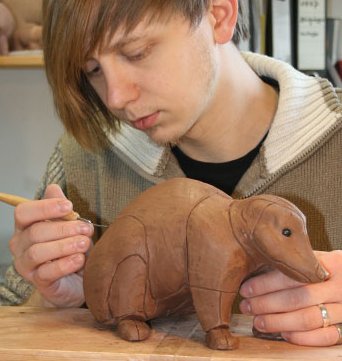After a period of fiduciary administration by the state, the company was expropriated in 1953 and nationalized as People’s Enterprises Doll-Making Workshops which continued producing traditional dolls.
The first plush animals were shown together with dolls at the Leipzig Trade Fair in 1959. These plush toys met with such high demand so that production was expanded, and doll production ceased in 1964. In 1969, the company was renamed as VEB Kösener Spielzeug. Up to 80% of the plush animal production was exported. The number of employees, mainly women, grew to 195.
For ten years, the company was subject to Burg Giebichenstein – College of Art and Design in Halle. These close ties resulted in many creative products, and some of its fine designers have worked for Kösen. The turning point in 1989 led to Kösen’s markets disappearing virtually overnight. Like many other companies, VEB Kösener Spielzeug was left with no hope for survival.
Awaiting privatization under the Treuhand Agency, Steiff showed an interest in Kösen which led to a two-year cooperation and a transfer of know-how. When Steiff decided not to buy Kösen, the local family business Schache stepped in to prevent the demise of the company, rich in tradition.
Dr. Schache was mayor of Bad Kösen at that time. Kösen changed direction and concentrated on producing high quality, lifelike plush animals. Graduate designers developed their own distinctive style in order to develop new plush animals. Today, the Kösen collection of lifelike plush animals is regarded as one of the best in the world.
Sometimes they assemble the patterns from the various individual patches, like for example: with the young wild boar; sometimes there are patterned fake furs available which can be used for example: the cow.
Selecting the perfect eyes is often very difficult as these are decisive for the facial expression of the animal. Only top quality plastic eyes are inserted, some of which are even customized products which are manufactured exclusively for Kösen. Generally the eyes are further accented by the special cut and the paint.
A particular distinction of the soft toys is that they are made up of a large number of individual pieces- more often than not, over seventy are involved.
As the pieces are frequently very small, stitching has to be done very carefully. The sewn pieces are then reversed and the safety eyes inserted.
To ensure that the animals are soft and cuddly and that they also maintain their shape over a long period, it is important that they are filled with the right stuffing. Many more procedures have to be carried out before the toy is ready i.e. sewing, shaping, combing, embroidering and painting.
Quality is controlled closely at each step in the production process.








